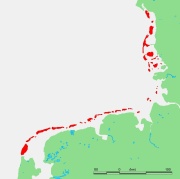The Netherlands gets a new king today. As a large part of his land is reclaimed sea or lakes, you will not be surprised to hear that one of his interests is water management. I previously wrote about the Cruquius Museum, set in a pumping station that emptied a lake in the west of the Netherlands. Centuries of fighting against the sea have made the Netherlands a world leader in land reclamation. Dutch engineers were responsible for draining the fens north of Cambridge in the UK, and improved the levee system in New Orleans after Hurricane Katrina.
 But even in the Netherlands, the sea sometimes wins. While the West coast is a neat line of dunes and dikes holding back the water, the North coast is a fringe of islands. These islands are part of the Frisian Islands archipelago that extends along the entire North coast of the Netherlands, the North East coast of Germany, and the South East of Denmark.
But even in the Netherlands, the sea sometimes wins. While the West coast is a neat line of dunes and dikes holding back the water, the North coast is a fringe of islands. These islands are part of the Frisian Islands archipelago that extends along the entire North coast of the Netherlands, the North East coast of Germany, and the South East of Denmark.
They weren’t always islands. At the end of the last ice age, they were the coast line. Continue reading “The Wadden Sea and Ecomare”




